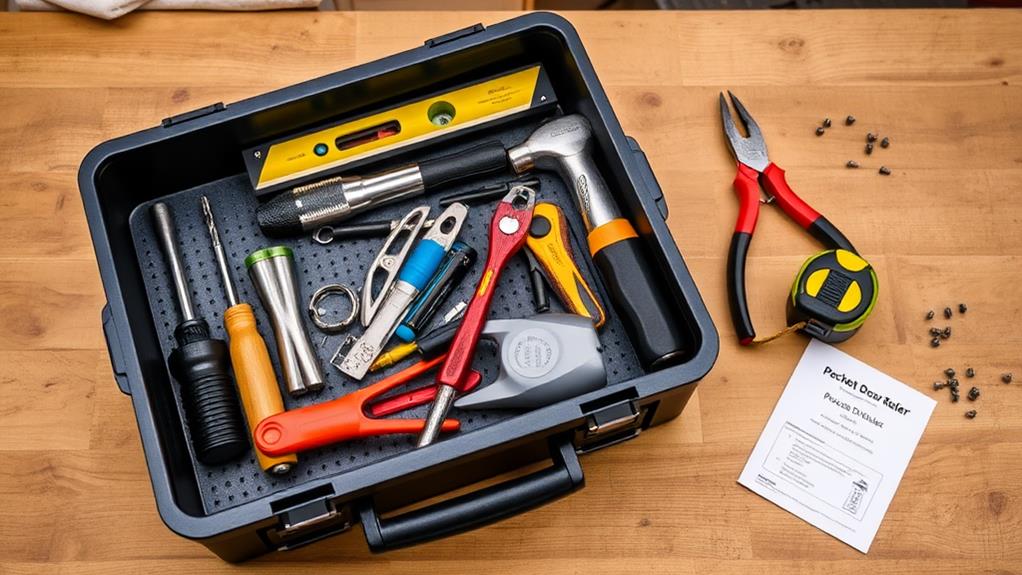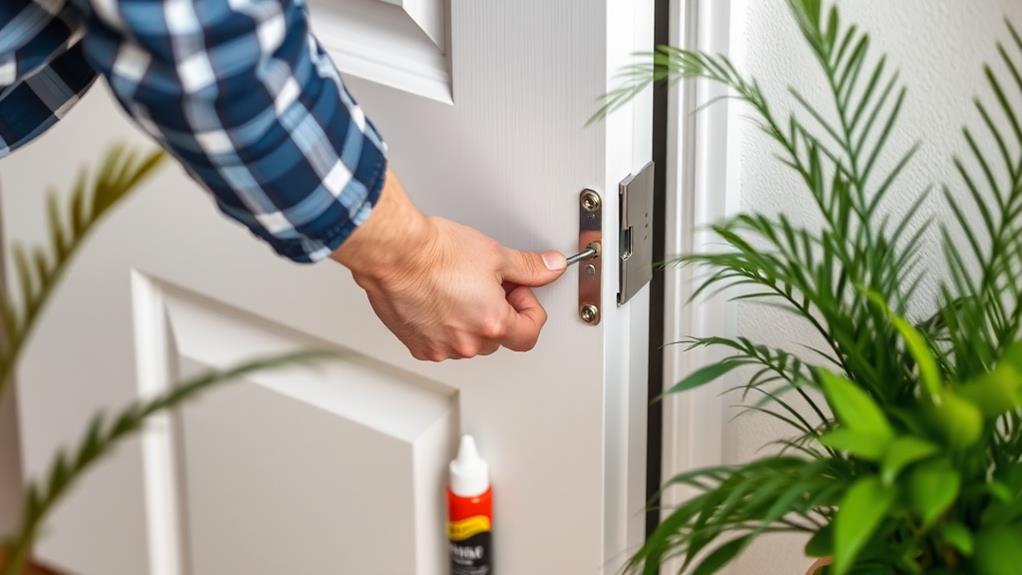Fixing a pocket door yourself is simpler than you think! Start by gathering essential tools like a utility knife, wrench, and white lithium grease. Inspect the door to check for misalignment or worn wheels. You may need to remove trim to access roller bolts and lubricate the tracks. Tighten any loose bolts and make sure the door hangs evenly. If wheels are worn, replacing them can greatly improve performance. Finally, reassemble the trim and test the door for smooth sliding. Stick around to discover more tips that can help make sure your pocket door operates like new!
Understanding Pocket Door Mechanics
When it comes to understanding pocket door mechanics, you'll find that these doors operate on a simple yet effective system. Pocket doors slide into the wall, utilizing wheels that run along a C-shaped track. This design allows for smooth opening and closing, but over time, the track can wear down or become misaligned.
Mechanical issues arise when wheels break, or doors get stuck and skewed within the wall pocket. Regular maintenance is vital; tools like those for expense tracking tools can help you keep track of costs associated with repairs.
To maintain your pocket doors, proper maintenance is vital. Regular lubrication of the track and wheels helps prevent friction and guarantees smooth operation. If you notice your door isn't gliding as it should, it's likely time for some repairs.
Accessing the wheels and track often requires specific tools, like a razor knife and small pry bar, to remove the casing and trim. Once you have access, check for any rust or bumps on the track that could hinder movement.
Confirming proper alignment of the wheels is essential for a seamless operation. By understanding these mechanics and performing regular maintenance, you can keep your pocket doors functioning effectively for years to come.
Common Pocket Door Problems
Pocket doors can run into a few common problems, mainly with the wheels and tracks.
Regular maintenance and inspection can help identify these issues early on, ensuring smooth operation and preventing costly repairs.
You might notice that the door jams or misaligns, making it tough to open or close smoothly.
Keeping an eye on these issues can save you a lot of hassle down the line, as proper expense tracking can reveal the cost of repair versus DIY solutions.
Wheel and Track Issues
Over time, the wheels on your pocket door can wear out or break, leading to frustrating issues like sticking or misalignment. If you notice these problems, it's probable due to the wheels or tracks needing attention.
The tracks, typically made of metal or nylon, can rust or develop bumps, creating friction that hinders smooth operation.
To tackle these wheel and track issues, start by carefully removing the trim and casing around the pocket door. This allows you to access the wheels without damaging the components, which you may want to reuse.
Once you've exposed the wheels, inspect them for wear and replace any that are damaged. When replacing wheels or tracks, it's critical to measure the existing components accurately so the new parts fit snugly in the pocket without excessive movement.
Regular maintenance can prevent these issues from arising. Lubricating the tracks with white lithium grease guarantees a smooth sliding experience.
Misalignment and Jamming Problems
Misalignment and jamming issues can be incredibly frustrating for anyone trying to use a pocket door.
These problems often stem from worn wheels or rusted tracks, leading to difficulty in sliding the door open or closed. You might notice gaps at the top of the door frame, signaling misalignment.
Here's how to tackle these common issues:
- Inspect the Wheels: Check for worn wheels that may need replacing. If they're damaged, it can cause jamming problems.
- Lubricate the Tracks: Regularly lubricating tracks with white lithium grease can enhance the sliding mechanism and prevent sticking.
- Adjust Roller Bolts: If the door isn't hanging evenly, remove the trim to access the roller bolts. Adjusting them can help realign the door.
- Consider Track Replacement: In severe cases, it might be necessary to replace the track entirely if it shows significant wear.
Tools Needed for Repair

When tackling a pocket door repair, having the right tools on hand makes the process smoother and more efficient. First, grab a utility knife; it's essential for cutting through staples and removing casing or trim without damaging surrounding materials.
You'll also need a wrench to tighten or adjust the roller bolts, ensuring the door hangs evenly and operates smoothly. Additionally, consider using a user-friendly app for expense management, such as Fyle which integrates advanced receipt scanning technology, as it can help you keep track of any costs associated with your repair project.
Next, keep some white lithium grease handy. This lubricant is perfect for applying to the tracks and wheels, reducing friction and improving the door's sliding action.
A screwdriver is vital for securing trim pieces back in place after the repair, as well as for accessing screws during disassembly.
In addition to these tools, basic hand tools like a five-in-one tool and a small pry bar will help you carefully pry off casing and trim pieces. This access allows you to inspect and repair the internal components of the door effectively.
Step-by-Step Repair Process
To start fixing your pocket door, gather the necessary tools like a razor knife, a five-in-one tool, and some heavy-duty screws.
It's also beneficial to have a plan for managing any unexpected costs during the repair process, similar to how one would approach bill tracking tools and apps for financial organization.
Next, you'll want to check the door alignment to guarantee it slides smoothly.
With everything ready, you can follow the step-by-step repair process for a hassle-free fix.
Tools Needed for Repair
Before diving into your pocket door repair, you'll want to gather the necessary tools to make the process smooth and efficient. Having the right tools at your side will save you time and frustration.
Here's a list of essential items you'll need:
- Utility Knife: Perfect for cutting staples and trimming any excess material.
- Wrench: Use this for tightening bolts and ensuring everything is secure.
- White Lithium Grease: Vital for lubrication; it keeps your door sliding smoothly.
- Screwdriver: Ideal for securing trim pieces and making adjustments.
You might also consider keeping a five-in-one tool handy, as it's great for removing casing and trim without causing damage.
A small pry bar can help with this as well. If you find yourself needing to cut new tracks, a reciprocating saw with metal cutting blades is essential.
Don't forget a putty knife for removing old caulk or paint and a level to check your door's alignment.
With these tools ready, you'll be on your way to successfully fixing your pocket door!
Adjusting Door Alignment
With your tools gathered and ready, you can now focus on adjusting the alignment of your pocket door. Start by carefully removing the trim pieces surrounding the door; be cautious to minimize damage during this process.
Once the trim is off, inspect the roller bolts. Tighten them to guarantee the door hangs evenly, eliminating any gaps at the top.
Next, it's essential to make any necessary adjustments to the roller itself. If the door still isn't aligned properly, you may need to adjust the height of the rollers.
After you've achieved the desired alignment, lubricate the door tracks with white lithium grease. This step is key for facilitating smooth sliding and guaranteeing ideal functionality.
Once you've finished these adjustments, reassemble the trim securely. Make sure it fits tightly against the wall, allowing for easy future adjustments if needed.
Adjusting the Door Alignment

Adjusting the alignment of a pocket door is essential for guaranteeing it operates smoothly and fits snugly within the frame. Proper maintenance and adjustments can also contribute to better financial management by preventing future repair costs.
Start by removing the trim pieces around the door jamb to access the roller bolts. This allows you to adjust them for proper hanging. Follow these steps:
- Check the Door's Alignment: Look for any gaps at the top or bottom, indicating that the door may be tilted.
- Adjust the Roller Bolts: Use a wrench to carefully tighten or loosen the roller bolts until the door hangs evenly.
- Lubricate the Track: After adjusting, apply white lithium grease to the track. This promotes smooth sliding and prevents future sticking.
- Reassemble Trim Pieces: Once everything is adjusted, put the trim pieces back to protect your adjustments and enhance the door's aesthetic appeal.
Regularly check the door's alignment and functionality, making minor adjustments as needed.
Replacing Worn Components
Replacing worn components of a pocket door can considerably improve its functionality and longevity. To get started, remove the trim and casing using a razor knife and small pry bar, being careful to minimize damage.
Once you have access, inspect the wheels and track for wear. If you find broken wheels or a rusted track, it's time to replace them with parts that match your existing system. Utilizing tools like budget management tools can help you allocate funds for these repairs.
During the installation of new wheels, make sure they're centered on the door and fastened securely with heavy-duty screws to maintain stability. For smooth operation, adjust the new wheels so they're evenly aligned and fit snugly within the track, avoiding any excessive wiggle room.
After replacing the components, reassemble the trim pieces carefully, ensuring they're securely attached. Don't forget to patch any nail holes or joints with spackle for a clean finish.
Maintenance Tips for Longevity

Your pocket door deserves regular attention to guarantee it continues to operate smoothly and lasts for years to come. Proper maintenance not only enhances functionality but can also help you save money in the long run by avoiding costly repairs.
By following these maintenance tips, you can prevent wear and keep your door in top shape:
- Inspect the Track and Wheels: Regularly check for signs of wear, such as rust or bumps, and address any issues promptly to avoid more significant repairs.
- Lubricate the Hardware: Every few months, apply white lithium grease to the track and wheels. This keeps them functioning smoothly and prevents sticking or jamming.
- Keep It Clean: Make sure the door and surrounding area are free from debris. A clean environment prevents obstructions that can lead to misalignment and hinder movement.
- Check Alignment: Periodically verify the alignment of the door. Adjust the roller bolts as necessary to ascertain even hanging and to prevent future issues.
For additional guidance on maintaining tools and equipment, check out top budgeting apps that help manage your home maintenance budget effectively.
Final Checks and Cleanup
After you've completed the repairs on your pocket door, it's important to perform some final checks and cleanup to make certain everything's in order.
Start by reinstalling the trim pieces, making sure there are no gaps. If you spot any, secure them with nails or screws as needed. This will help create a polished look.
Additionally, maintaining clear communication about your door's functionality can enhance your overall satisfaction, similar to how clear payment terms can improve customer relationships.
Next, patch any holes or joints left from the trim removal using spackle. Allow it to dry completely, then sand the area for a smooth finish.
If you have cracks to repair, apply joint compound and let it dry thoroughly before sanding to achieve an even surface.
Once everything looks good, it's time to test your work. Confirm that all components are securely fastened and operational.
Slide the door back and forth to make sure it moves smoothly and closes properly.
Conclusion
Fixing a pocket door can be as straightforward as pie once you understand its mechanics and tackle common issues. By following the step-by-step guide, you can adjust or replace components right at home. With a little patience and the right tools, you'll have your door sliding smoothly again. Remember, regular maintenance is key to keeping it functioning well, just like oiling a well-loved bicycle chain to guarantee a smooth ride.



